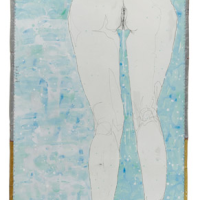47. DEL KATHRYN BARTON

In the past decade Del Kathryn Barton has become one of Australias most recognisable and collectable artists. Born in Sydney in 1972, Barton graduated from the University of NSW with a Bachelor of Arts in 1993. She won her first Archibald prize in 2008 for her self-portrait with her two children, and again in 2013 for her portrait of actor Hugo Weaving. In 2017 she had her first solo exhibition at the National Gallery of Victoria, The Highway is a Disco, which featured her acclaimed film RED which starred Cate Blanchett and encapsulated her multiple interests in feminism, nature and the maternal figure.
Barton is celebrated for the frank sexual assertiveness of her imagery of women and for her compulsive exploration of the feminine; the present work is a powerful example of both. Her matter-of-fact depictions of genitalia are direct and totally without coyness or apprehension, often using the vulva as an icon of generative power rather than something obscene to be concealed. Unsurprisingly, Barton had the following quote by Louise Bourgeois (1911-2010, French/American), twentieth century feminist and surrealist, pinned to her studio wall for many years:
everything is out there she is exposed. She reacts because she is vulnerable, but this is what she wants Sexuality is in the open. The erotic is everything the subject is everythingeroticism is stronger than religion. It is dangerous.1
Barton notes that the naked body in her vulnerable and sexually frank drawings is always her own, as she wants to take full responsibility for the intimate images and would not ask another woman to expose herself in this way.2 These female figures are depicted nude demonstrating that they have nothing to hide. Or, to put it in a more traditional way, and reminiscent of the writings of John Berger on the nude, in their nakedness they are complete.3
Alongside this nakedness, oversized eyes are a signature motif, repeated throughout Bartons oeuvre, and again reiterated in the present work. Large eyes, either wide open or half closed as here, speak to an insistence on watchfulness. Rather than female nudes in art who seem to be unaware of being observed, Bartons figures look back at their viewers, in an excess of awareness that subverts the usual viewer/subject relationship.
Bartons calm and assured handling of sexual imagery comes from a sense of creative confidence and empowerment that she inherited from her female line. Her grandmother, Nancy Barton, had an exceptional talent for domestic craft work and Barton lived with her for a year while at art school in Sydney. Her mother, Karen Barton, was a craft artist who encouraged Bartons artistic tendencies from a young age and shaped her aesthetic sensibilities.4 They have worked together on a number of fabric pieces throughout her life, including hand-stitched, padded silk borders such as this one, used as a framing device.
This blurring of the lines between fine art and domestic craft is recurrent in Bartons work. She repeatedly uses needlework and craft alongside painting and drawing, combining the highest and the lowest mediums of the traditional artistic hierarchy. Of this she remarks that she always finds categorisation so tedious Everythings collapsing in a really great way.5 Furthermore, in doing so she is reappropriating the traditionally female domains of domestic craft to discuss female sexuality with candour.
Writer and curator, Julie Ewington, sums Barton up best when she says:
Barton, like Courbet, Schiele, the Surrealists, Vivienne Binns and Louise Bourgeois, among many others, participates in a long and distinguished lineage of artists committed to ruthless frankness about sexual desires and relationships and unwillingness to recognise the restraints of social convention on its expression in their art.6
Footnotes
1. Ewington, J., Del Kathryn Barton, Piper Press, Sydney, 2014, p.163
2. Ibid, p.146
3. Berger, J., Ways of Seeing, Penguin, London, 1972
4. Fortescue, E., Del Kathryn Bartons major new exhibition honours the mother who never got to see it, The Daily Telegraph, 20 November 2017
5. Dewey, I., Spiders, Bunnies and Armani Suits: Del Kathryn Barton Hits New York, Broadsheet, 22 June 2017
6. Ewington, J., Del Kathryn Barton, Piper Press, Sydney, 2014, p.163
Asta Cameron BA, MA (Art Curatorship)